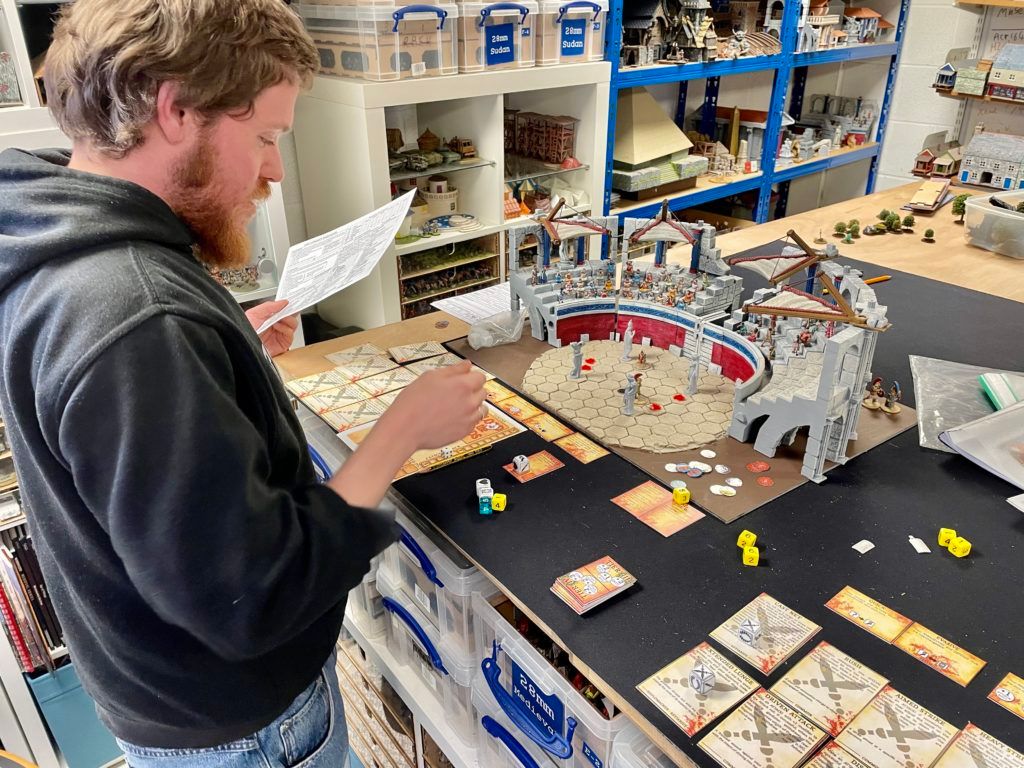
A month or so ago, Frank Sultana kindly sent me the current play test version of Blood on the Sands. I’m a big fan of all things Roman and have tried out a few Gladiator rule sets over the years. My son, Lewis came over to visit at the start of this week, and he also is a keen gamer, so we decided to give the game a go!

Frank has very generously made an introductory version of the game available from the games Facebook page.
If you follow the link and go to the file section you can download introductory rules, character sheets, hex gaming board and tokens… everything you need to play apart from some dice.

The introductory rules come with character sheets already completed for the classic match up between a Murmillo and a Thraex. The game is very much a game of resource management and tough decision making. The core mechanic will be familiar to anyone who has played What a Tanker, What a Cowboy or Saga. Each gladiator has a set of six action dice. Each turn these are rolled. You can make a special set, or use plain D6. Each face allows a different action (Move, Recover, Defend, Attack, Special Attack or Wild Card). The gladiator who has the most move results get the initiative and goes first.

Attack results allow you to attack your opponent. Special Attack results allow you to choose a more elaborate attack mode from a selection of common and class specific options. Common special attacks include attempting to Rush or land a Heavy Blow. The class specific attacks give the flavour of a particular class and style of fighting. For example the Thraex with there special curved sword (Sica) can attempt to get around there opponents shield with the ‘Elusive Strike’ special attack. The defender gets an opportunity to avoid the blow, maybe improving the odds by parrying with there shield and spending more defence dice. Both attacks and defences are carried out with 2D6 rolls with a straightforward and logical set of modifiers. If the attack beats the defenders defence a hit is achieved. The location and severity of the wound are then determined. Wounds range from inconsequential scratches to killing blows. Often it is cumulative fatigue that determines a winner and a loser. More severe wounds cause bleeding that doubles the amount of fatigue a gladiator takes.

When a gladiator concedes because they have tripped or have run out of fatigue they appeal to the crowd for mercy. The decision of the crowd is affected by how well they have fought and of course a dice roll!

Once we had played out first match using the introductory rules, we felt we were ready to try the full blown rules. We both took on the roles of a provincial Lanister, running a Ludi to supply gladiators to the local games. We each rolled up six gladiators and allocated them to the six classes covered by the rules (Hoplomachus, Murmillo, Provocator, Retiarius & Thraex). Creating our gladiators involved determining there origin, ancestry and starting traits. One of my gladiators was ‘Quick’ so it made sense to train him as a Retiarius, the lightly armed gladiator with trident and net.

We decided our first campaign would be for a single year. This has 4 events, with each Lanister entering a gladiator into two events. Both the event, and the individual match can have unique circumstances. The whole event took place on a ‘blood soaked arena’ as the arena staff had not done a good job clearing up after the mornings executions and beast hunts. This meant there were some trip hazards in the arena. The first match was characterised by one gladiator having ‘bad omens’ and in the second match the ‘training posts’ had been left out, adding even more hazards.

The first match we played was (like the introductory game) a pairing of a Murmillo and a Thraex followed by a Retiarius vs a Provocator in the second match. Lewis won the first match after my Thraex passed out with multiple head wounds. He had fought well and the crowd spared him, but he was left with an unhealable wound to his head which will disadvantage his future career. The second match was won by my Retiarius. This really is a testament to how well Frank has balance the abilities and drawbacks of different classes. I really did not see how he could survive in the arena against a heavily armoured opponent, but his speed and abilities did give him an even chance. After several unsuccessful throws of the net, and suffering some minor wounds he did eventually entangle his opponent, who dropped his sword and took a number of savage lunges with the trident. When he appealed to the mercy of the crowd, they called for his blood and he nobly knelt in submission.

The player aids for the game are very good. This is the layout for my Retiarius in my second match. The battle board sows how many wounds can be taken in each location, together with armour, which in this case is not much. At this point he has thrown his net, so we see an empty hand token to represent this. The larger cards are the ‘Special Attack’ options, some are common and some are just for a particular class. The smaller cards represent the gladiators traits, some are unique to the individual and some are related to his class.
We both really enjoyed playing Blood on the Sands and can’t wait for it to be released. It is sure to be a winner, it is definitely the most characterful and fun to play Gladiator game that I have tried. Lewis and I are going to try to continue the campaign with some matches played over ‘Zoom’, so I will let you know how that goes.
The introductory Blood on the Sands game can be downloaded from the Facebook group, click here to take a look.

0 Comments